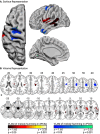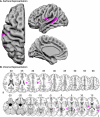This is a preprint.
Causal Lesion Evidence for Two Motor Speech Coordination Networks in the Brain
- PMID: 40501547
- PMCID: PMC12157638
- DOI: 10.1101/2025.06.05.658124
Causal Lesion Evidence for Two Motor Speech Coordination Networks in the Brain
Abstract
Speech production is supported by sensory-to-motor transformations to coordinate activity of the larynx and orofacial muscles. Here, we show that lesions to left temporal lobe areas involved in pitch processing cause reduced neural responses when repeating sentences and when humming piano melodies in a dorsal portion of the left precentral gyrus linked to laryngeal motor control. In contrast, lesions to left inferior parietal areas involved in somatosensory processing of speech cause reduced neural responses when repeating sentences but not when humming piano melodies in a ventral portion of the left precentral gyrus linked to orofacial motor control. Analyses in neurotypical participants converge in showing that the dorsal and ventral portions of the left precentral gyrus exhibit strong functional connectivity to left temporal and inferior parietal regions, respectively. These results provide causal lesion evidence that dissociable networks underlie distinct sensory-to-motor transformations supporting laryngeal and orofacial motor control for speech production.
Keywords: functional MRI; left precentral gyrus; left superior temporal gyrus; left supramarginal gyrus; lesion-symptom mapping; melody humming; sentence repetition; speech production.
Conflict of interest statement
Conflicts of interest. BZM is an inventor of IP PCT/US2019/064015 for a process to develop predictive analytics in neurosurgery. BZM is also a co-founder, and Chief Science Officer, of MindTrace Technologies, Inc., which licenses said intellectual property from Carnegie Mellon University.
Figures





Similar articles
-
Visual processing of manipulable objects in the ventral stream is modulated by inputs from parietal action systems.bioRxiv [Preprint]. 2025 Jun 3:2025.06.01.657280. doi: 10.1101/2025.06.01.657280. bioRxiv. 2025. PMID: 40501973 Free PMC article. Preprint.
-
Vocal pitch enables differential motor learning of speech segments.J Neurophysiol. 2025 May 1;133(5):1382-1391. doi: 10.1152/jn.00605.2024. Epub 2025 Mar 18. J Neurophysiol. 2025. PMID: 40098484 Free PMC article.
-
Interventions for childhood apraxia of speech.Cochrane Database Syst Rev. 2018 May 30;5(5):CD006278. doi: 10.1002/14651858.CD006278.pub3. Cochrane Database Syst Rev. 2018. PMID: 29845607 Free PMC article.
-
Cognitive and motor impulsivity in the healthy brain, and implications for eating disorders and obesity: A coordinate-based meta-analysis and systematic review.Cortex. 2024 Feb;171:90-112. doi: 10.1016/j.cortex.2023.10.008. Epub 2023 Oct 31. Cortex. 2024. PMID: 37984247
-
The multifaceted nature of inner speech: Phenomenology, neural correlates, and implications for aphasia and psychopathology.Cogn Neuropsychol. 2025 Jul 3:1-21. doi: 10.1080/02643294.2025.2527983. Online ahead of print. Cogn Neuropsychol. 2025. PMID: 40611622 Review.
References
-
- Van Den Berg J., Myoelastic-aerodynamic theory of voice production. J Speech Hear Res, 1958. 1(3): p. 227–44. - PubMed
-
- Levelt W.J., Speaking: From intention to articulation. 1993: MIT press.
-
- Guenther F.H., Neural Control of Speech. 2016: The MIT Press.
-
- Guenther F.H. and Hickok G., Role of the auditory system in speech production. Handb Clin Neurol, 2015. 129: p. 161–75. - PubMed
-
- McKay L.C., et al. , Neural correlates of voluntary breathing in humans. J Appl Physiol (1985), 2003. 95(3): p. 1170–8. - PubMed
Publication types
Grants and funding
LinkOut - more resources
Full Text Sources
